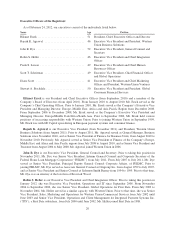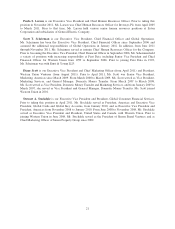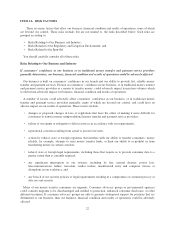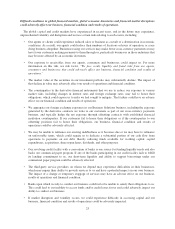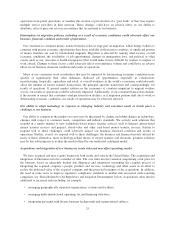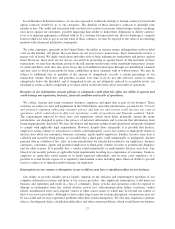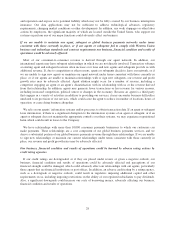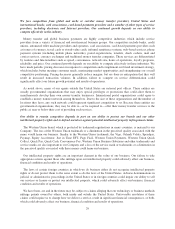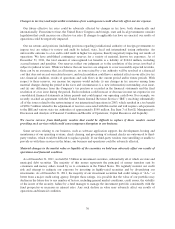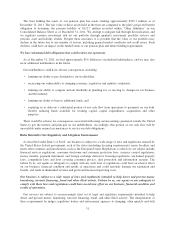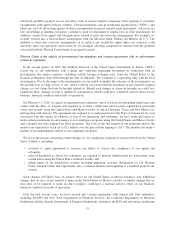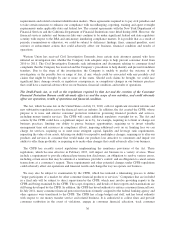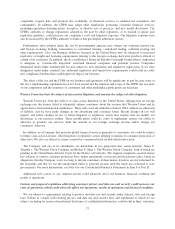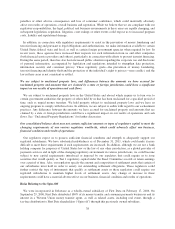Western Union 2011 Annual Report Download - page 36
Download and view the complete annual report
Please find page 36 of the 2011 Western Union annual report below. You can navigate through the pages in the report by either clicking on the pages listed below, or by using the keyword search tool below to find specific information within the annual report.We face competition from global and niche or corridor money transfer providers, United States and
international banks, card associations, card-based payments providers and a number of other types of service
providers, including electronic and Internet providers. Our continued growth depends on our ability to
compete effectively in the industry.
Money transfer and global business payments are highly competitive industries which include service
providers from a variety of financial and non-financial business groups. Our competitors include banks, credit
unions, automated teller machine providers and operators, card associations, card-based payments providers such
as issuers of e-money, travel cards or stored-value cards, informal remittance systems, web-based services, phone
payment systems (including mobile phone networks), postal organizations, retailers, check cashers, mail and
courier services, currency exchanges and traditional money transfer companies. These services are differentiated
by features and functionalities such as speed, convenience, network size, hours of operations, loyalty programs,
reliability and price. Our continued growth depends on our ability to compete effectively in these industries. We
have made periodic pricing decreases in response to competition and to implement our brand investment strategy,
which includes better meeting consumer needs, maximizing market opportunities and strengthening our overall
competitive positioning. Pricing decreases generally reduce margins, but are done in anticipation that they will
result in increased transaction volumes. In addition, failure to compete on service differentiation could
significantly affect our future growth potential and results of operations.
As noted above, many of our agents outside the United States are national post offices. These entities are
usually governmental organizations that may enjoy special privileges or protections that could allow them to
simultaneously develop their own money transfer businesses. International postal organizations could agree to
establish a money transfer network among themselves. Due to the size of these organizations and the number of
locations they have, any such network could represent significant competition to us. Because these entities are
governmental organizations, they may be able to—or be required to—offer their money transfer services to the
public at, near or below their cost of providing such services.
Our ability to remain competitive depends in part on our ability to protect our brands and our other
intellectual property rights and to defend ourselves against potential intellectual property infringement claims.
The Western Union brand, which is protected by trademark registrations in many countries, is material to our
Company. The loss of the Western Union trademark or a diminution in the perceived quality associated with the
name would harm our business. Similar to the Western Union trademark, the Vigo, Orlandi Valuta, Speedpay,
Paymap, Equity Accelerator, Just in Time EFT, Pago Fácil, Western Union Payments, Western Union Quick
Collect, Quick Pay, Quick Cash, Convenience Pay, Western Union Business Solutions and other trademarks and
service marks are also important to our Company and a loss of the service mark or trademarks or a diminution in
the perceived quality associated with these names could harm our business.
Our intellectual property rights are an important element in the value of our business. Our failure to take
appropriate actions against those who infringe upon our intellectual property could adversely affect our business,
financial condition and results of operations.
The laws of certain foreign countries in which we do business either do not recognize intellectual property
rights or do not protect them to the same extent as do the laws of the United States. Adverse determinations in
judicial or administrative proceedings in the United States or in foreign countries could impair our ability to sell
our services or license or protect our intellectual property, which could adversely affect our business, financial
condition and results of operations.
We have been, are and in the future may be, subject to claims alleging that our technology or business methods
infringe patents owned by others, both inside and outside the United States. Unfavorable resolution of these
claims could require us to change how we deliver a service, result in significant financial consequences, or both,
which could adversely affect our business, financial condition and results of operations.
29



